
Acting Chairwoman Caroline D. Pham of the U.S. Commodity Futures Trading Commission (CFTC) announced the launch of a new initiative to allow the use of tokenized collateral and stablecoins in derivatives markets. This move marks a significant step forward for the CFTC in digital asset regulation and innovation. The CFTC is calling on market participants and the public to submit comments by October 20, 2025.
CFTC Promotes "American Crypto Golden Age"
In her statement, Pham noted that the CFTC has been continuously promoting crypto policy since the beginning of the year, describing this period as the beginning of the "Golden Age of Crypto in the United States." At the historic "Crypto CEO Forum" held in February 2025, industry and regulatory bodies held in-depth discussions on how to leverage blockchain technology to improve collateral management efficiency and boost market liquidity. She stated, "The tokenized market is the future, and the use of stablecoins in collateral management is a 'killer app.'"
Industry heavyweight support: from Circle to Coinbase
Several well-known crypto companies expressed support for the plan:
Circle President Heath Tarbert said that the GENIUS Act has paved the way for stablecoins issued by licensed companies in the United States. In the future, stablecoins such as USDC can be used as collateral in the derivatives market, which will reduce costs, increase liquidity, and achieve "24/7" market efficiency.
Coinbase Vice President Greg Tusar emphasized that stablecoins will completely change the operating model of the derivatives market. Now that there is a clear regulatory framework, the United States must ensure that it stays ahead in global tokenization innovation.
Crypto.com, Ripple, and Tether also joined in the praise
Other leading crypto companies have also expressed their support:
Crypto.com CEO Kris Marszalek believes that allowing the use of non-cash collateral (such as BTC and CRO) in compliance with regulations will make the US market more competitive. Jack McDonald, Ripple's Vice President of Stablecoins, emphasized that tokenized collateral, when accompanied by clear valuation, custody, and settlement rules, will enhance market trust and promote efficiency. Tether CEO Paolo Ardoino noted that the global market capitalization of stablecoins has reached nearly $300 billion, and their integration into US financial infrastructure will accelerate settlement efficiency and deepen market liquidity.
Recommendations from GMAC and the White House Task Force
The development of this initiative is no accident. As early as last year, the CFTC's Global Markets Advisory Committee (GMAC) recommended expanding the use of distributed ledger technology (DLT) to handle non-cash collateral. A report from the White House Digital Asset Markets Task Force further requested that the CFTC provide guidance on the adoption of tokenized collateral.
Regulatory Sandboxes and Pilot Programs
Pham has proposed establishing a "regulatory sandbox" for digital asset markets, using pilot programs to provide clearer regulations for the industry while ensuring adequate risk mitigation measures. The CFTC successfully promoted market innovation through pilot programs in the 1990s and will continue this model this time.
Public comments open until October 20
The CFTC is seeking public and industry comment on the following topics:
- GMAC 2024 Annual Recommendations
- The suitability of tokenized collateral in regulated margin lending
- Potential digital asset market pilot program
- Revise relevant CFTC rules to conform to the White House report (particularly pages 52-53 regarding collateral management)
Comments can be submitted through the CFTC website and will be made available on CFTC.gov .
The article "U.S. CFTC Promotes "Tokenized Collateral and Stablecoin" Plan, Tokenization Market Has Become a Trend" first appeared on ABMedia ABMedia .







